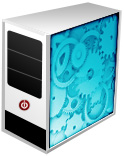Dig Deeper Into Your PC:
Understanding Device Drivers
Learn about the critical files that keep your PC components playing nicely together.
 Have you ever wondered how the dozens of different components within your computer know how to work together without running into each other?
Have you ever wondered how the dozens of different components within your computer know how to work together without running into each other?
- How does your printer know how to print documents?
- How do your speakers know how to play music?
- How does your screen know how to draw windows, icons, and pictures?
- How does your mouse know how to move your pointer around?
How do all of these different parts from various manufacturers stay organized and ensure your computer does what it’s supposed to do?
The unsung heroes that make all of the above possible are technically known as “device drivers” (or just “drivers” for short). Device drivers are system files that translate the complex commands issued by you, the operating system, and your familiar programs into simpler instructions that the hardware components (“devices”) of your PC can actually understand and execute.
For example, the software in your internet browser needs to be able to talk to the electronics in your network adapter to actually receive information that allows you to navigate web pages and load their content. Your games and other programs need to be able to tell your screen how to draw windows and graphics, and understand your keyboard and mouse actions.
Drivers are the interpreters for all this and more. Every device in your computer has its own very specialized driver that’s created, provided, and maintained by that device’s manufacturer. Most of the hundreds of device drivers on your computer today were installed along with Windows when your computer was originally manufactured, while others you may have actually added yourself without realizing it… by inserting a CD provided with a monitor, printer, digital camera or other peripheral you may have purchased separately.

Let’s look at drivers in a different way…
Imagine you’re in a foreign country where you don’t speak the local language. In order to help you communicate, you’ve brought along a dictionary with a list of common phrases and their translations.
If your dictionary contains the most authoritative, up-to-date, and accurate information available for both your language and the language of the country you’re in, then you will be able to communicate with everyone that you meet.
But if your dictionary is incomplete, out of date, or written for the wrong language or dialect, you will certainly run into problems and limitations. For example, you may think you’re asking for directions to the train station—but because one of the words in your dictionary is wrong, what you’re really asking for is directions to the harbor.
In the same way, each hardware component in your computer speaks its own language, and you can think of device drivers as files that act as the “dictionaries” that teach your PC’s hardware components how to communicate with one another and the programs and software you’ve installed on your computer.
Device drivers are loaded into and run within a very critical and sensitive part of your PC: the Windows kernel, which is the core of your computer’s operating system—so a communication error caused by an incompatible driver can severely affect the entire system.
How to ensure drivers don’t let you down
Establish a roll-back plan in case a faulty driver is installed: Using Windows Restore Points
Because drivers play such a critical role in your computer’s overall stability, it’s important to avoid introducing problems by unintentionally installing incompatible or untested drivers. However, if a faulty driver accidentally makes its way into your PC, it’s important to have a plan in place that allows you to “roll-back” to a previously stable configuration.
Here’s how to use the Restore Point feature in Windows for basic roll-back functionality:
| Step 1. Before knowingly installing a driver, open Windows System Restore and create a restore point for your PC. The steps to create a restore point depend on the Windows version. |
| To create a restore point: |
| Windows XP: |
|
| Windows Vista and 7: |
|
| Step 2. After installing a driver, restart the PC and work with your computer and its devices for a day or so. |
| Step 3. If anything seems awry, open Windows System Restore and use it to “roll-back” to the previous configuration. The roll-back procedure depends on the Windows version. |
| To restore a previous configuration: |
| Windows XP: |
|
| Windows Vista and 7: |
|
Avoid untested drivers from device manufacturers
Many device manufacturers make new and unproven drivers (called “beta” versions) available from their websites for download by the adventurous few who can accept the risk associated with trying untested versions. It is not recommended to install beta version device drivers on your primary business or personal computers. Make sure that any driver update that you’re downloading and installing on your computer has been fully tested for compatibility with your system. Look for a “final” or “production” version to download instead.
Occasionally, even a final version device driver can have unforeseen interactions with other device drivers installed on your computer. Having a way to undo the effects of a broken driver install is essential, especially if the new driver causes conflicts, errors, or other problems. The Windows Restore Point functions discussed above do provide basic roll-back functionality, but it’s always wise to perform a full backup of the system and any important documents for “maximum insurance” against any unforeseen problems associated with an unwanted driver installation.








